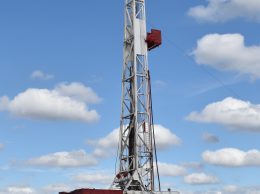Op/ed: Putting oil on the road to nowhere
By Carl Pope
Is this the beginning of the end for oil’s long, tyrannical reign?
Amid turmoil in two of the world’s largest oil-producing regions, Russia and the Persian Gulf, the price of oil has declined from $110 in last summer to below $70 last week. Explanations for the drop are many, ranging from an oil glut resulting from booming U.S. shale oil production to a Saudi plot to make U.S. shale unprofitable by driving down the price.
Volatility in the price of oil is nothing new. The essential dynamic — the global economy riding a roller coaster in which the cost of crude jerks and swerves from a punishing $125 per barrel to a still-painful $60 to $70 — is well established. But over the past two years, prices stabilized in the range of $90 to $110 per barrel. Then, last summer, oil began its precipitous dive.
The decline has much to do with supply and demand in North America. U.S. shale oil production is up 3.6 million barrels a day since 2010. Canada has added another 1.5 million barrels per day from tar sands. At the same time, U.S. consumption has declined by an adjusted 3.3 million barrels per day. New vehicles are 25 percent more efficient than models five years ago, and younger Americans are driving fewer miles.
Seven years ago, oil companies, starry-eyed over the prospect of increased demand driving the price of oil to $150 per barrel, went an on investment binge. New wells in the Arctic, Central Asia and deep-water ocean sites have proved disappointing, yielding too little oil in return for too much capital. Nonetheless, they are beginning to produce. Meanwhile, Libyan oil has returned to market and Persian Gulf crude has kept flowing in spite of Islamic State and civil war in Syria. Supply elsewhere has increased as well.
The International Energy Agency estimated that roughly 2.6 million barrels per day is now, in investment terms, stranded — priced too low to repay the capital spent developing it. Yet because most of those costs are sunk, even unprofitable crude keeps flowing. Meanwhile, Iran, Iraq and Venezuela desperately need to keep pumping oil to cover their budgets.
This is the closest thing to a free market in oil we have seen in years. OPEC is not manipulating this price crash; it simply is refusing to act like a cartel and defend artificially high prices. The result is ugly for producers.
Is cheap oil sustainable? Maybe not. As the growth of U.S. shale production slows and the global economy accelerates, oil demand will eventually overrun supply. There won’t be as much oil from new tar sands or deep-ocean drilling coming to market. The IEA has warned that unless the price of oil remains above $100 per barrel, even OPEC countries will fail to invest enough in new production to provide reliable supplies a decade from now. Consulting company IHS Cera warns of prices over $140.
That’s one scenario. Here’s another: Only a few automobiles in today’s U.S. fleet meet new federal fuel economy standards. In 2025, when all cars meet the regulations, U.S. gasoline consumption should decline another 20 percent. The European Union, China and India have all recently adopted even tougher fuel standards. If the Obama Administration adopts ambitious fuel economy targets for trucks, other markets will follow.
The decline of driving may also have staying power; many in the auto industry are treating it not as a fluke, but as a global downshift. In the U.S. and around the world, young people are seeking more urban, less auto-dependent living. Moreover, when they do drive, more will be driving electric vehicles, which are already cheaper to own and operate in states where auto companies offer their best lease terms. Major truck fleets, including FedEx, have committed to switching their long-haul trucking from diesel to natural gas.
The biggest risk is complacency. With prices well below $100, nations and consumers could easily delude themselves into believing that oil is a safe monopoly fuel and that continued progress on fuel economy is too burdensome. That would be devastating to global prosperity, climate and geopolitics.
Instead, we need more policies such as California’s low-carbon fuel standard to accelerate the transition from oil dependence, even as oil grows cheaper.
Oil as a transportation fuel will be around for a few more decades. But oil as a hazardous monopoly fuel is now merely one of multiple options. It’s up to us: We have choices — cars powered by electricity or natural gas, and public transportation systems that render cars superfluous in densely populated zones. We can unhitch economic growth from oil, making our climate more stable and our economies richer. We can leave oil’s tyranny behind.
•Carl Pope is the former executive director at the Sierra Club and a writer for Bloomberg View. Reach him at [email protected].












